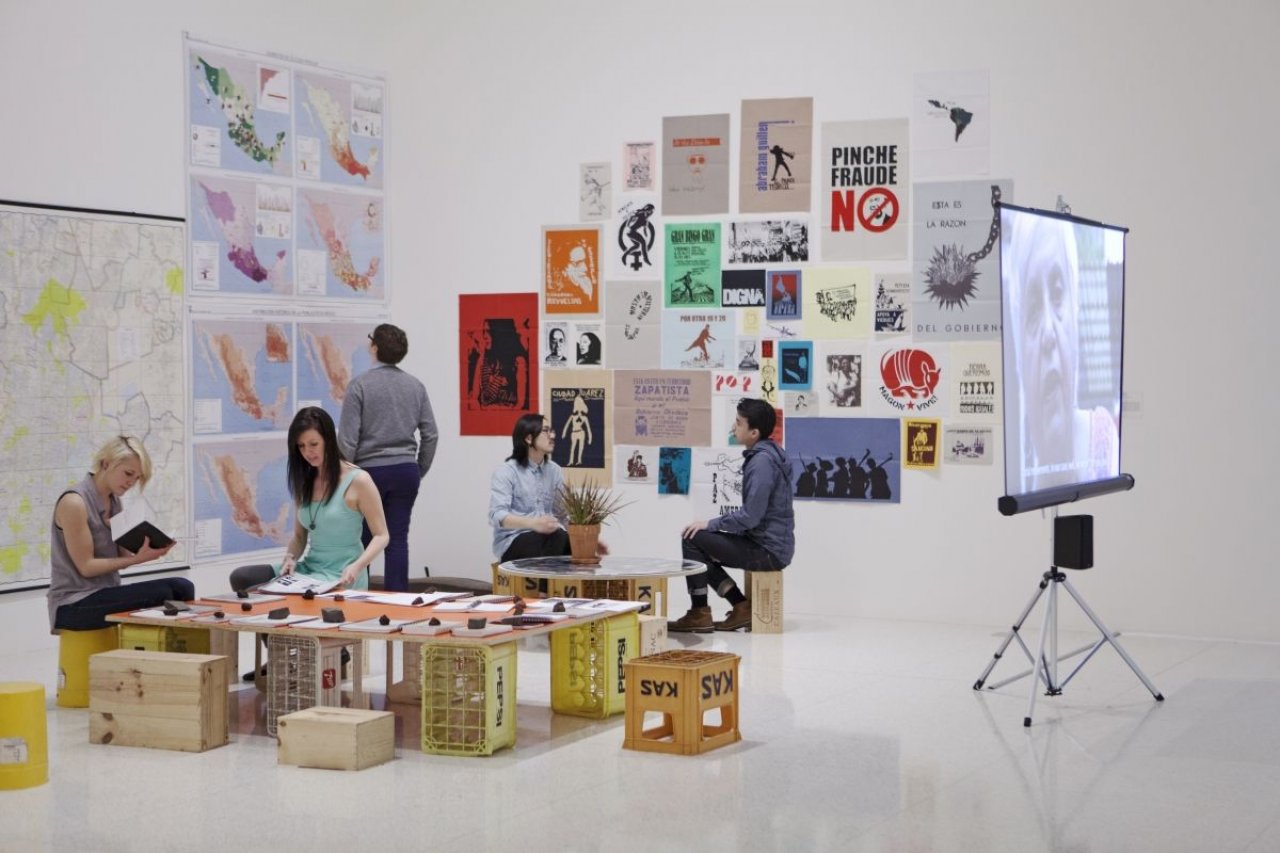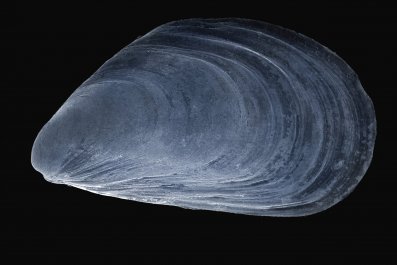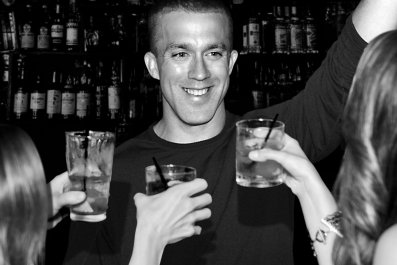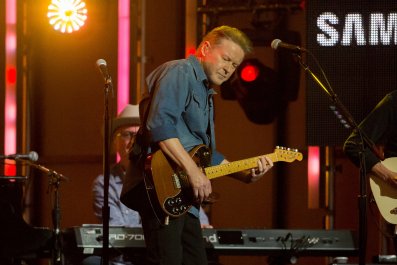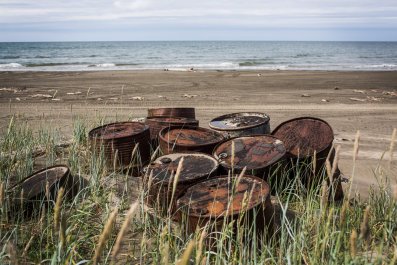With less than two weeks to go before his new sculpture went on show in Europe's most spectacular exhibition space—the cavernous Turbine Hall of London's Tate Modern gallery—Mexican artist Abraham Cruzvillegas seemed remarkably unconcerned that construction workers in fluorescent high-visibility vests and hard hats were still piecing the work together. "Duchamp said his work was definitively unfinished, and that's how I think of mine as well," says Cruzvillegas, referring to Marcel Duchamp, the French-American conceptual artist, to whom he is often compared.
Even with the work having gone on public display on October 13—resuming the sequence of headline-making exhibitions in the Turbine Hall that began in 2000 and paused in October 2012—Cruzvillegas's Empty Lot is not finished. The sculpture consists of a series of earth-filled triangular boxes arranged on two large triangular ramps on scaffolding. One of the ramps slopes forward from the balcony to meet the floor of the Turbine Hall as it rises toward the entrance. The other ramp rises toward the wall of this former power station at the back. The boxes are filled with soil, which Cruzvillegas and the project's curator, Mark Godfrey, collected from different parts of London, including Hyde Park, the Horniman Museum in South London, Buckingham Palace and the gardens of Godfrey's children's school.
The plots of earth will be watered throughout the exhibition, although Cruzvillegas has not seeded them with crops or flowers. Godfrey raised the possibility that visitors might "seed-bomb" the boxes, casting handfuls of seed that might take root and grow, but Cruzvillegas seems more interested in what the soil might already contain.
The original series of installations in the Turbine Hall, which were sponsored by Unilever, ran for 12 years from the opening of Tate Modern in 2000 and produced many memorable works, from Louise Bourgeois's creepy opening display of giant spiders, to popular successes like Olafur Eliasson's giant indoor sun and Ai Weiwei's carpet of porcelain sunflower seeds. People would come to lie on the floor and bask in the comforting light of Eliasson's manufactured sun or shoot down the five giant Carsten Hller installations in the space. Thirty million people saw works exhibited in the Unilever series, and they helped establish Tate Modern, as Britain's pre-eminent venue for modern and contemporary art. The exhibits became so central to the perception of contemporary art that since they ended in 2012, when the Anglo-German artist Tino Seghal filled it with performers and storytellers in a piece called These Associations, the British and European art worlds have felt incomplete.
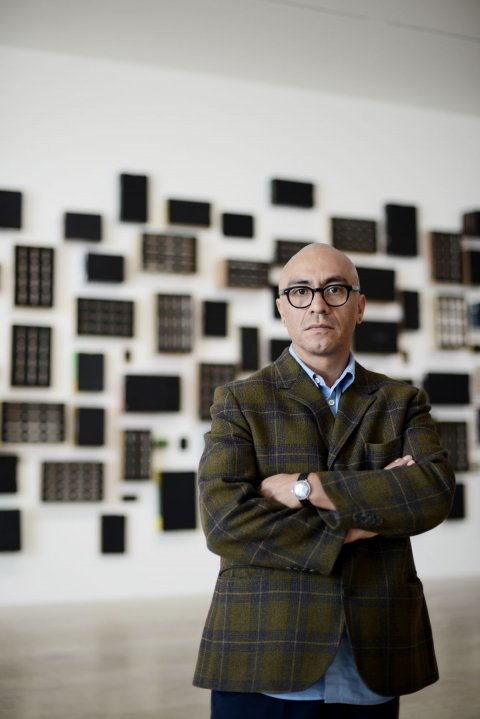
The new series of installations inaugurated by Empty Lot coincides with significant changes at the Tate organization, which also includes London's Tate Britain as well as two other galleries in Liverpool and St. Ives. Two years ago, Tate Britain, the organization's original home on the north bank of the Thames, 2 miles upstream from Tate Modern, completed a $68 million renovation, and at Tate Modern work has nearly finished on an extension that will add 60 percent more display spacemuch needed in an institution that is half the size of the Museum of Modern Art (MoMA) in New York but attracts twice as many visitors. The Swiss architects Jacques Herzog and Pierre de Meuron, who oversaw the transformation of the main building, have designed the new wing. Some parts of the development, including the transformation of the former power station's cylindrical tanks into what Tate calls the "world's first museum spaces dedicated to live art and performance," have already been completed, and a brick-clad building called Switch House will open next June.
The Turbine Hall was closed to visitors while the work was going on. High above its sloping floor, a new bridge connects level four of the existing galleries to the extension, and a connecting door has been installed in the south wall. Hyundai Motor Company has signed up to fund the new series of exhibits until 2025. The deal represents the longest initial commitment from a corporate sponsor in Tate's history and eis part of its attempt to compete with other major museums, like MoMA and the Museum of Contemporary Art in Los Angeles. If Tate is edging ahead—the influential art magazine Art Review listed Tate's director, Sir Nicholas Serota, as No. 1 on its 2014 Power 100 list, noting that no other museum "can match Tate's international reach and institutional authority"then that is partly due to the scale and prestige of the reopened Turbine Hall.
Cruzvillegas seems undaunted by the responsibility of being the artist asked to reopen the sequence. Part of his calm may stem from Empty Lot's being the latest part of a long sequence of works he calls autoconstruccin, which he translates as "self-construction" or "construction of the self." Autoconstruccin has taken many different forms in the 10 years that he has been making itsculpture, video, music and installationbut it is always an attempt to explore the nature of life in Ayusco, the district of Mexico City where he grew up.
His parents settled in Ayusco in the 1960s and attempted to make a home on its inhospitable volcanic terrain, despite the fact that settlement was illegal. "No one thought anyone would be able to live there, but they started constructing houses in any way they could, with whatever materials they could find," he says. His family was poor, but Cruzvillegas says that "in a way, we were richer, because we were able to construct a social fabric in which the capital was not money but solidarity." He talks about his parents with great affection, but he says he is not attempting to re-create their lives or offer a literal representation of life of Ayusco. Instead, he is trying to recover the experience of a particular moment in history when the promise of progress and development collapsed, and people were forced to improvise. "What I'm trying to understand is how all energy can take a different shape in space, in different places and different times, and using different materials."
The explanation makes sense of the curious hybrid of Empty Lot, which looks like a cross between a South American favela and a vegetable patch, with its raised beds of London earth made from rough wooden boards and its lamps fashioned from material that Cruzvillegas found on the streets or in skips. Yet the local material that fascinates him most is the scaffolding that holds up its angled platforms. "I have said many times that autoconstruccin was scaffolding, but I meant it as a metaphorand now it's not," he says." It is real. I'm very happy about this work because it makes my metaphors visible: It's a synthesis of all my work in the most simple way."
He says it is "a nice coincidence" that the rear wall of Herzog and de Meuron's extension is also clad in scaffolding, which both conceals and reveals its shape, for it emphasizes the fact that the installation in the Turbine Hall is not just a work of art but an extension of the ever-changing fabric of the city, and he looks forward to the day Empty Lot is taken down. He likes the thought that the boxes of earth with their unknown cargo will be returned to London's parks and gardens, and its scaffolding will be reabsorbed into the city, then remade in a different form. The provisional nature of the sculpture fills with him hope"the hope of becoming myself," as he puts itbut he does not want to impose an interpretation on the work that will inaugurate the reopened Turbine Hall: He wants it to be open-ended enough to mean different things to each one of the millions of people who will see it. "We are not giving it a specific interpretation," he says. "Anything is welcome."


